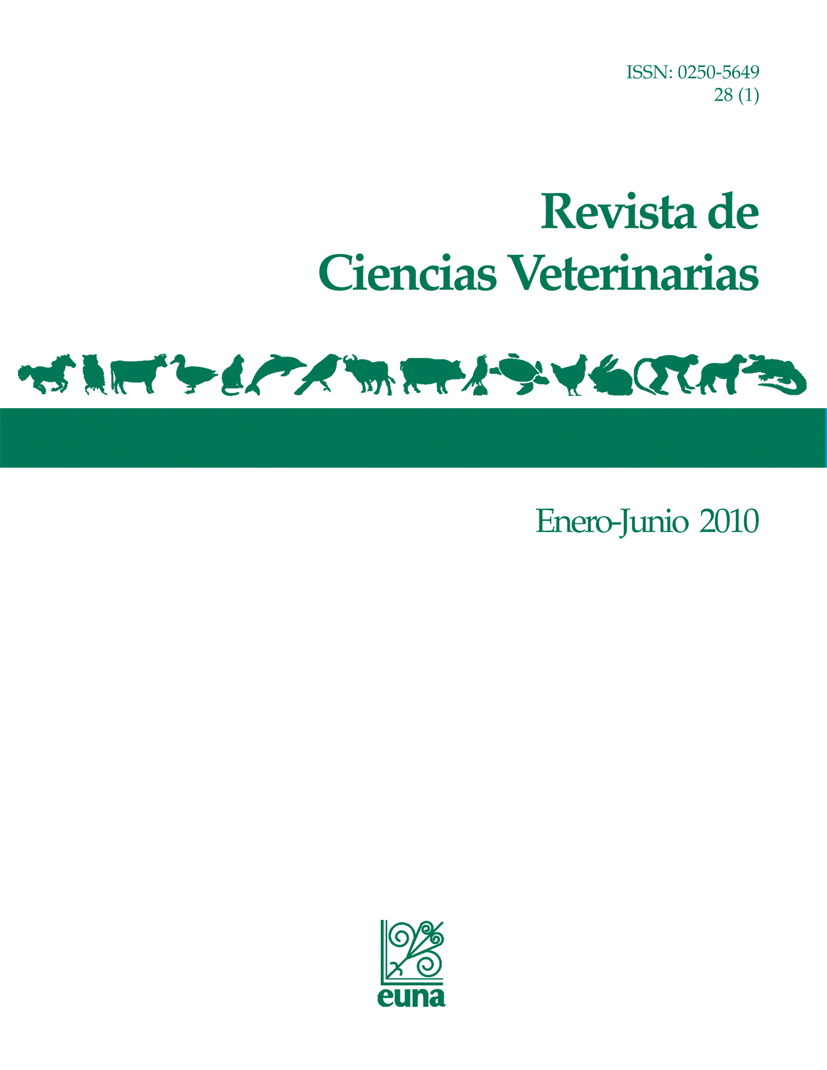Effect of time on the stability of hematological variables in dog blood samples
Keywords:
whole blood, preservation, hemogram, time, caninesAbstract
The aim of this study was to assess the effect of the time of storage of dog blood samples. Hematological variables studied included: Hematocrit, hemoglobin, mean corpuscular hemoglobin concentration (MCHC), leukocyte and differential leukocyte counts. Samples were collected from 40 dogs of different breed, age, sex, and clinical condition treated at the Hospital for Small and Wild Species of the School of Veterinary Medicine (EMV) from Universidad Nacional in Costa Rica, during the period from August 2007 to May 2008. Blood samples were taken from the cephalic vein, using the vacuum system (Vacutainer ®) with disodium salt of ethylenediaminetetraacetic acid (EDTA) as an anticoagulant. Samples were analyzed in the Laboratory of Clinical Analysis at the EMV and were kept at a temperature of 39.2°F (4°C).Methodologies used included conventional manual methods. Each sample was analyzed four times; the first analysis was done during the first hour after sampling, and successively at 24, 48 and 72 hours. Statistical analysis (SAS ver.9.2) included the calculation of descriptive statistics
for each hematological variable, a comparison of means for each of the variables in the time, according to the data grouped in terciles in order to assess the possible effect of concentration and cellularity. Results showed minimal not significant differences over time; therefore, clinical or biological implications, and thus the possibility of establishing a wrong clinical diagnosis, is unlikely, given the stability of the hematological variables analyzed.
References
Aécio de Oliveira C. J., D. Ribeiro Filho, J. D. Guimarães, A. R. Silva, W.de Ferreira Dantas, L. de Paula BonfáI, and S. Kreutzfeld de Farias. 2010. Concentração de anticoagulante, tempo e temperatura de armazenagem sobre os parâmetros hematológicos no hemograma automatizado. Cienc. Rural 40: 2221-2226.
Cohle, S., D. A. Saleem, and D. E. Makkaoui.1981. Effects of storage of blood on stability of hematologic parameters. Am. J. Clin. Pathol. 76:67–69.
Doyle, C. T. 1967. The effect of blood volume and choice of anticoagulant on the PVC, MCHC and total white cell count. Irish journal of medical scince. [en línea] 42: 429-435. Consultado 21 de Julio 2011. http://www.springerlink.com/content/c3m1230l68v19127/.
Freise, K. F., R. Schmidt, L. Gingerich, P. Veng-pedersen and, A. Widness. 2009. The effect of anticoagulant, storage temperature and dilution on cord blood hematology parameters over time. Int. J. Lab. Hematol. 31: 496–504.
Hendrix, Ch. M. 2002. Laboratory procedures for veterinary technicians. 3rd. ed. Mosby, Missouri, U.S.
Hinton M., and D. R. E. Jones. 1978. The haematological examination of canine blood samples received by post: the influence of delay in examination on red cell parameters. J Small Anim Pract.18:95–99.
Hirase, Y. 1992. Stable blood cell after one week storage at room temperature. Bulletin of Environmental Contamination an Toxicology. [en línea] 49: 504-508. Consultado 16 de Setiembre 2010. http://www.springerlink.com/content/g80x7234308q782g/.
Malcom, D., E. Roderick, and J. Lumsden. 1998. Manual of small animal clinical pathology. British Small Animal Verterinary. London, UK.
Médaille, C., A. Briend-Marchal, and J. P. Braun. 2006. Stability of selected hematology variables in canine blood kept at room temperature in EDTA for 24 and 48 hours. Vet. Clin. Pathol. 35:18-23.
Meneses, A., J. Villalobos y E. Sancho.1993. Manual de hematología y química clínica en medicina veterinaria. FUNA, Heredia, C.R.
Meyer, D., and J. Harvey. 1998. Veterinary laboratory medicine interpretation and diagnosis. 2nd. ed. Saunders, Pa., U.S.
Penny, R. H. C., C. H. Carlisle. H. A., Davidson, and E. M. Gray. 1970. Some observations on the effect of the concentration of ethylenediamine tetra acetic acid (EDTA) on the packed cell volume of domesticated animals. Br.Vet. J.126: 383-389.
Rosato, P. N. R., F. G. V Gama, M. A. Brunet., M. O. S. Gomes, and A. E. Santana. 2009. Effects of storage time and temperature on biochemistry results from canine serum. Abstract Nr. 288. Proceedings of the 34th World Small Animal Veterinary Congress WSAVA 2009. São Paulo, Brazil.
SAS. 2009. SAS [CD-ROM] Version 9.2. Cary, SAS Institute Inc., U.S.
Sáenz, G., R. Jiménez, B. Valverde, L. Salazar, J. Orlich, M. Chaves, L. Salazar, M. Alvarado, y A. Barrantes. 2003. Hematología analítica. 4th.ed. EDNASSS, San José. CR.
Schalm, O., N. C. Jain, and E. J. Carroll. 1975. Veterinary hematology. 3rd. ed. Lea & Feiberg. U.S
Thrall, M. 2004. Veterinary hematology and clinical chemistry. Lippincott Williams & Wilkins.Md. U.S.
Weiss, D. J., and K. J. Wardrop. 2010. Schalm’s. Veterinary Hematology. 6th. ed. Blackwell Publishing U.S.
Willard, M., y H. Tvedten. 2004. Diagnóstico clínico patológico práctico en los pequeños animales. 4a ed. Intermédica, Buenos Aires, Arg.
Downloads
Published
How to Cite
Issue
Section
License
Licensing of articles
All articles will be published under a license:

Licencia Creative Commons Atribución-NoComercial-SinDerivadas 3.0 Costa Rica.
Access to this journal is free of charge, only the article and the journal must be cited in full.
Intellectual property rights belong to the author. Once the article has been accepted for publication, the author assigns the reproduction rights to the Journal.
Ciencias Veterinarias Journal authorizes the printing of articles and photocopies for personal use. Also, the use for educational purposes is encouraged. Especially: institutions may create links to specific articles found in the journal's server in order to make up course packages, seminars or as instructional material.
The author may place a copy of the final version on his or her server, although it is recommended that a link be maintained to the journal's server where the original article is located.
Intellectual property violations are the responsibility of the author. The company or institution that provides access to the contents, either because it acts only as a transmitter of information (for example, Internet access providers) or because it offers public server services, is not responsible.







